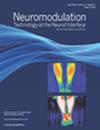Frequency-Specific Effects of Noninvasive Median Nerve Stimulation on Gastric Slow Wave Activity in Humans
IF 3.5
3区 医学
Q2 CLINICAL NEUROLOGY
引用次数: 0
Abstract
Objectives
The present study explored the effects of different frequencies of noninvasive median nerve stimulation (nMNS) on two autonomic responses: gastric slow waves under water-loading condition and heart rate variability (HRV). To the best of our knowledge, this is the first study to document the effects of different frequencies of nMNS on gastric slow waves (GSW) in humans under 5-minute water-loading condition.
Materials and Methods
Twenty healthy adult participants were fitted with a noninvasive body-surface gastric mapping, electrocardiogram (ECG), and a transcutaneous electrical nerve stimulation device and administered with four different nMNS frequencies (placebo-0 Hz, 40 Hz, 120 Hz, and 200 Hz) on four separate counterbalanced days. After the baseline and stimulation periods, a 5-minute water-load test was applied, and a post–water-load period also is recorded for ECG and GSW activity. Time-domain HRV parameters are analyzed with repeated-measures one-way analysis of variance (ANOVA) and a post hoc Tukey multiple comparison test. Parameters that failed normality tests underwent a Freidman test with a post hoc Dunn multiple comparison test. GSW data are analyzed with repeated-measures mixed-effects ANOVA.
Results
In empty stomach (baseline vs stimulation), only the 40-Hz frequency statistically significantly (p = 0.0129) increased GSW amplitude in comparison with its own baseline. In full (distended) stomach, 40-Hz and 200-Hz stimulations showed a statistically significant difference (post hoc multiple comparison adjusted, p = 0.0016 and p = 0.0183, respectively) in the Gastric Rhythm Index in comparison with the change obtained by placebo stimulation (baseline vs poststimulation periods); 120-Hz nMNS showed a statistically significant difference (p = 0.0300) in the stress index in comparison with the decrease observed in the placebo group. However, 120-Hz nMNS did not induce a statistically significant change in gastric electrical activity compared to placebo stimulation. The nMNS did not follow the linear “dose-response” relationship between nMNS frequency and gastric/HRV parameters.
Conclusions
The 40-Hz and 200-Hz nMNS frequencies showed the most promising results in response to gastric distension, in addition to 40 Hz for an empty stomach. Further research is essential to explore the potential therapeutic effects of these frequencies on gastric diseases such as gastroparesis, gastroesophageal reflux disease, and functional dyspepsia that can be used in wrist wearables.
无创正中神经刺激对人体胃慢波活动的频率特异性影响
研究目的本研究探讨了不同频率的无创正中神经刺激(nMNS)对两种自律神经反应的影响:水负荷条件下的胃慢波和心率变异性(HRV)。据我们所知,这是第一项记录 5 分钟水负荷条件下不同频率正中神经刺激对人体胃慢波(GSW)影响的研究:20 名健康的成年参与者安装了无创体表胃图、心电图(ECG)和经皮神经电刺激装置,并在四个不同的平衡日接受了四种不同频率的 nMNS 刺激(安慰剂-0 Hz、40 Hz、120 Hz 和 200 Hz)。在基线期和刺激期之后,进行 5 分钟的水负荷测试,并记录水负荷后的心电图和 GSW 活动。时域心率变异参数采用重复测量单因素方差分析(ANOVA)和事后Tukey多重比较检验进行分析。对未通过正态性检验的参数进行弗里德曼检验和事后邓恩多重比较检验。GSW 数据采用重复测量混合效应方差分析:结果:在空腹时(基线与刺激),只有 40 赫兹频率的 GSW 振幅与自身基线相比有显著的统计学意义(p = 0.0129)。在饱满(膨胀)的胃中,40 赫兹和 200 赫兹刺激与安慰剂刺激(基线与刺激后)所获得的变化相比,胃节律指数有显著的统计学差异(经事后多重比较调整,分别为 p = 0.0016 和 p = 0.0183);120 赫兹 nMNS 与安慰剂组所观察到的压力指数下降相比,有显著的统计学差异(p = 0.0300)。不过,与安慰剂刺激相比,120 赫兹 nMNS 并未引起胃电活动发生统计学意义上的显著变化。nMNS 频率与胃/HRV 参数之间不存在线性 "剂量-反应 "关系:结论:40 赫兹和 200 赫兹 nMNS 频率对胃胀气的反应显示出最有希望的结果,此外,40 赫兹对空胃的反应也显示出最有希望的结果。要探索这些频率对胃病(如胃痉挛、胃食管反流病和功能性消化不良)的潜在治疗效果,必须开展进一步的研究,这些研究可用于腕式可穿戴设备。
本文章由计算机程序翻译,如有差异,请以英文原文为准。
求助全文
约1分钟内获得全文
求助全文
来源期刊

Neuromodulation
医学-临床神经学
CiteScore
6.40
自引率
3.60%
发文量
978
审稿时长
54 days
期刊介绍:
Neuromodulation: Technology at the Neural Interface is the preeminent journal in the area of neuromodulation, providing our readership with the state of the art clinical, translational, and basic science research in the field. For clinicians, engineers, scientists and members of the biotechnology industry alike, Neuromodulation provides timely and rigorously peer-reviewed articles on the technology, science, and clinical application of devices that interface with the nervous system to treat disease and improve function.
 求助内容:
求助内容: 应助结果提醒方式:
应助结果提醒方式:


